Top 10 Best Small Business Tools for Growth & Success
The best small business tools for 2026 form a strategic tech stack designed to automate operations, improve efficiency, and drive growth.
This includes essential software for accounting, like QuickBooks Online, project management with platforms such as Asana and Trello, and marketing automation using Mailchimp.
Tying it all together, communication hubs like Slack ensure seamless team collaboration, allowing owners to focus on strategy rather than administrative tasks.
- Trello enhances project management by providing an adaptable platform for task organisation and team collaboration.
- QuickBooks Online simplifies financial management with invoicing, expense tracking, and real-time financial insights.
- HubSpot CRM improves customer relationships by effectively tracking leads and managing customer interactions.
- Mailchimp enables efficient email marketing through automated campaigns, audience segmentation, and performance tracking.
1. Project Management – Trello

Ah, project management – the backbone of any successful venture. Multiple tasks, deadlines, and team members can quickly become a nightmare without the right tool. Enter Trello, your new organisational superhero!
Just think about a virtual whiteboard where you create boards, lists and cards to map your workflow. It is simple to easily assign tasks with due dates and attach files using its drag-and-drop interface!
You can also collaborate in real time, so there will be no more endless email threads or miscommunication.
But what sets Trello apart from other tools? Its adaptability! Whether running a marketing campaign, launching a product or organising your daily tasks list, Trello works for you.
Not only this, but there are power-ups available, which means integration with apps such as Google Drive, Dropbox and Slack, among others – making it customisable for all needs.
Trello in Action
Picture being a graphic designer who handles several client projects simultaneously. In this scenario, if you use Trello, each client could have their board represented by different stages (To-Do, In Progress).
Shifting cards through lists like these can easily overlook progress, keeping clients satisfied, knowing what has been accomplished at any given time and holding them accountable.
2. Invoicing and Accounting – QuickBooks Online
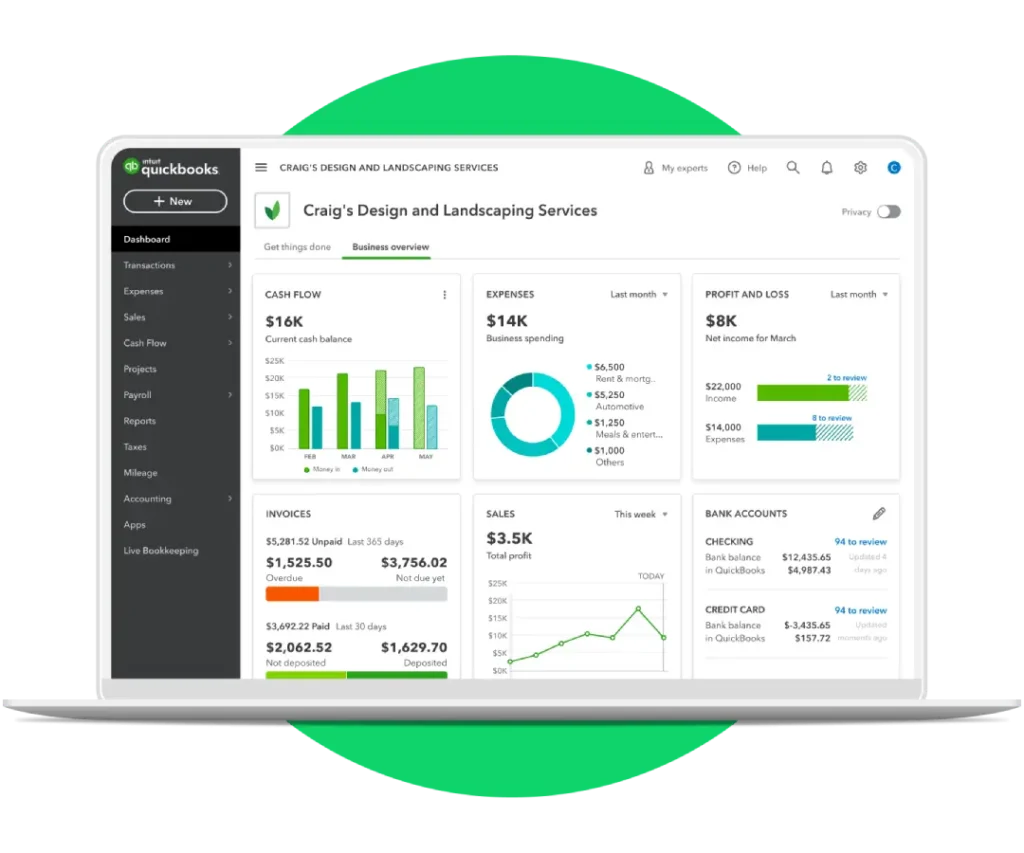
Managing finances for small businesses can be overwhelming. Tracking expenses, sending invoices, and reconciling bank statements are just a few of the many tasks that need to be taken care of in accounting. Fortunately, there is QuickBooks Online!
This game-changing cloud-based accounting software is perfect for small businesses. It has an intuitive interface, and robust features can simplify financial management while you say goodbye to nightmares about spreadsheets.
One feature that makes QuickBooks Online stand out is its ability to create invoices. Professional-looking and personalised invoices can be sent directly to your clients in just a few clicks.
Moreover, for those regular clients who pay the same amount every month, you can also set up recurring invoices that will save time and reduce the chances of missed payments.
But it’s not only about invoicing; there are also powerful tools for tracking expenses, managing payroll automation and generating reports within one centralised location offered by this platform.
With real-time financial data at your fingertips, making informed decisions becomes easy, while staying on top of your business’s financial health remains possible.
QuickBooks Online is in use
Suppose you are a consultant working with various clients across different industries. Using QuickBooks Online, each client may receive custom-made invoices containing your branding and specific project information.
Payment reminders could also be created to ensure timely payments, cutting down on follow-ups.
Also, if you have ever struggled during tax season when categorising personal and business expenses, this tool would serve amicably well since it allows users to track such expenditures and sync bank accounts quickly, thus making everything clear-cut.
3. Customer Relationship Management (CRM) – HubSpot CRM
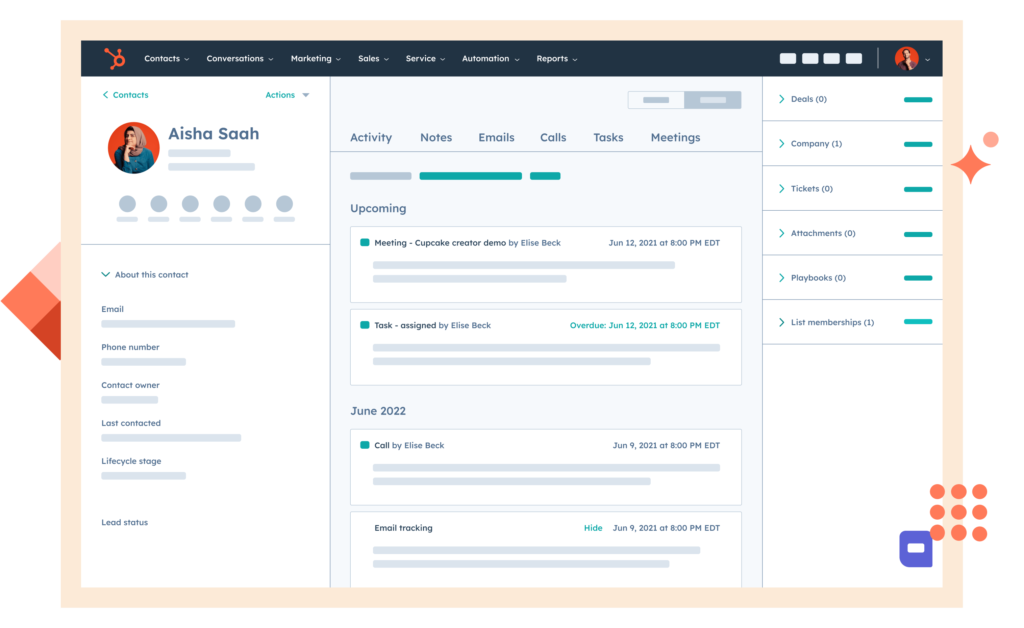
When it comes to small businesses, one of the primary tasks is building solid relationships with customers. This could mean anything from caring for leads to post-sale support, hence the need for a robust CRM system like HubSpot CRM.
HubSpot CRM is an all-inclusive, user-friendly platform enabling you to oversee your customer journey, from lead capture to after-sales support.
Its easy-to-use interface seamlessly integrates with other HubSpot tools, such as Marketing Hub and Sales Hub, helping you automate your sales and marketing processes while ensuring no lead slips.
Among the many features that make HubSpot CRM stand out is its ability to manage leads effectively. With this software, tracking and qualifying leads becomes easy; you can assign them to relevant staff members and set automated follow-up tasks and reminders – each contact receives personalised attention, increasing conversion rates.
This doesn’t stop at managing potential clients, though, because another thing about HubSpot, or any good HubSpot alternative, is how well it manages customer interactions and tracks closed deals.
Finally, we have detailed reports showing where every sale stands at any given time, together with related information about customers involved in those transactions!
How does HubSpot CRM work?
For example, let’s assume your company deals with digital advertising agency services that explicitly target social media platforms like Facebook and X.
What happens is this: using various methods such as forms on websites, events organised within local communities, etc., people interested in these services will fill out their details, thereby becoming leads which HubSpot CRM can capture from different sources, including website forms, social media channels such as Facebook or X, among others.
Therefore, once captured, they are automatically fed into sales pipelines created within this software package so that each step along the way towards converting them into loyal clients.
4. Email Marketing – Mailchimp

Digital mail advertisement is necessary for any small business to reach its clients and increase sales. When considering email marketing tools, no other platform beats Mailchimp.
Even a person with no design background can easily create visually appealing emails thanks to the friendly user interface and intuitive nature of Mailchimp’s design.
Additionally, there are many templates that you can modify depending on your needs; you may also use drag-and-drop editors if necessary.
However attractive it may be, this service does not stop at being beautiful only! It comes packed with powerful functionalities that help divide audiences into smaller groups so that each group gets what suits them best.
It automates campaigns based on different triggers or events while tracking their performance against set goals. Combined, all these features make Mailchimp an excellent choice for anyone who wants to succeed with their email marketing strategy.
Mailchimp In Action
For instance, you run a small online store dealing with planet-friendly household items. The newsletter created through MailChimp can be used to keep subscribers updated about new product launches or services offered, discounts given exclusively to them, and tips shared concerning the sustainability within homes.
Dividing your list according to interests shown by recipients during the subscription process, followed by activities carried out afterwards, will ensure every reader receives messages that they connect with most, which will deepen their involvement and encourage more purchases from such individuals.
You could also automate email workflows aimed at nurturing fresh sign-ups into abandoned carts recovery programs, which would trigger re-engagement activities towards those who have failed to show any activity within a specified period, after which such tasks will continue running without manual intervention until the recipient responds or becomes active again.
With sufficient know-how, one can always rely on Mailchimp’s robust reporting capabilities that enable users to track campaign performance using data from different sources and then make appropriate decisions to improve this channel’s effectiveness consistently.
5. Social Media Management – Buffer

Small businesses must establish a solid online presence to succeed in social media. Nonetheless, juggling many different social media accounts can quickly become an overwhelming waste of time. This is where Buffer comes into play – it streamlines your social media management and ensures you never miss a beat.
Buffer is powerful and user-friendly; this tool allows users to schedule posts for multiple platforms from one place. You can publish content on Facebook, X, Instagram, Pinterest, LinkedIn, etc., without logging into each individually or manually.
The feature that sets Buffer apart most notably is its ability to schedule content. With an intuitive calendar display setting, you can plan out all your posts well in advance so they publish regularly throughout each day. Not only will this save time, but it will also help keep up an organised appearance across every channel you subscribe to – something which tends to look better and work better.
However, Buffer doesn’t stop there! It offers comprehensive analytical tools alongside report functionalities, such as tracking how well your posts are doing, among other things.
You can use these insights gained from seeing which pieces did best when they were shared or clicked on (for example) – Armed with such information, any savvy marketer would be able to tweak their strategy accordingly, ensuring future success while also giving customers what they want more often than before.
These features will allow users to see what resonates most with their followers, further refining our understanding of why specific content performs better than others. Don’t tell us anything new about human nature.
How Does Buffer Work?
To give you an idea of just how valuable this tool could be for your bakery, let me paint a picture: Let’s say you’re running a small bakery with relatively high levels of engagement through various platforms, especially those like Instagram, where people tend to follow food-related accounts religiously (I mean, who doesn’t love looking at pictures delicious treats).
You could use Buffer to pre-schedule all those mouth-watering photos and unique offer posts that are guaranteed to get likes, shares, etc., across days, weeks, months on end – giving off a vibe of being active constantly without having to be so.
6. Team Communication – Slack
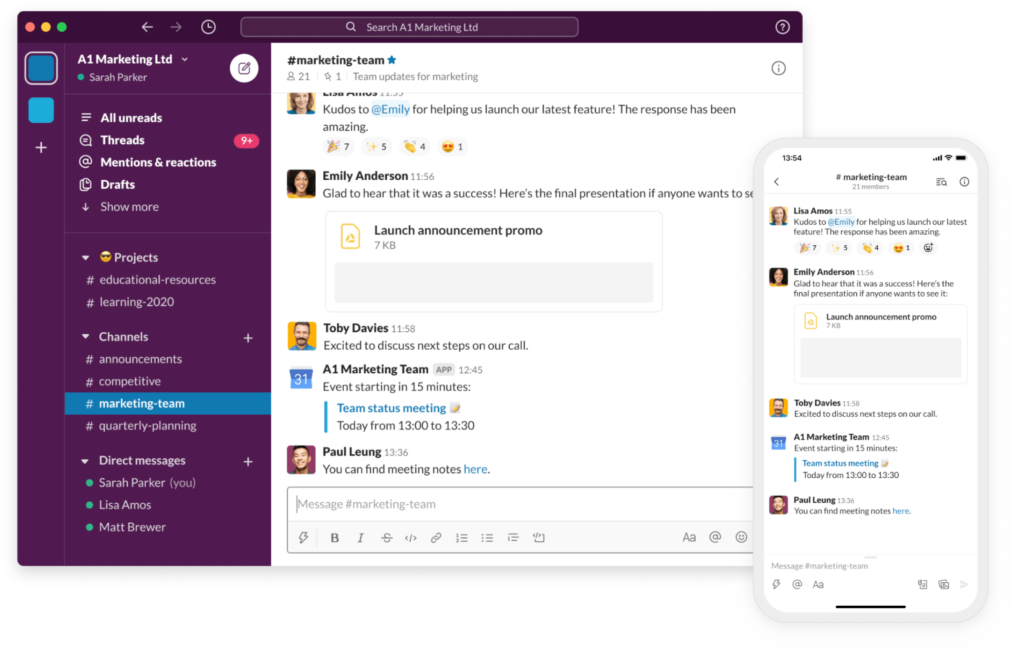
No matter how successful, any team needs effective communication to hold them together – and in today’s world, where remote work is becoming more prevalent, the right communication tool is a must.
Slack is a cloud-based platform designed for teams. It brings your team’s communication and collaboration tools into one place, so you don’t have to switch between different applications. In other words, it is like having one ample centralised workspace that connects seamlessly with others.
The channels on Slack are simple and easy to use. Create a channel for each project or topic if need be; this ensures that everything stays organised and not mixed up. If an update or document must be shared within the team, put it in the relevant channel for all members to access.
Integration may be my favourite feature of Slack. You can connect many third-party apps (such as Trello, Google Drive, and Asana) with it to work together smoothly without causing inconveniences or disruptions within your workflow system, thus saving time by moving less often!
Though it may seem like only text-based communication tools are offered here on Slack, nothing could be further from the truth! Video calls can also be made, allowing face-to-face meetings even when miles apart from colleagues (instrumental during brainstorming sessions).
With the audio calling feature available, making quick check-ins has never been easier, either – no matter where anyone might reside physically at any given moment – space continuum!
Trust me when I say that Slack will constantly revolutionise small business collaboration!
7. Cloud Storage – Google Drive

Presently, in the business world, data is everything. Therefore, having a safe place to store and share your files is essential. Enter Google Drive: a reliable cloud storage solution for small businesses that’s also easy to use.
Google Drive is part of the Google Workspace suite (formerly G Suite) and is integrated with other essential tools such as Gmail, Google Docs, Sheets, and Slides, among others.
There are free storage options with enough space for most people and affordable plans if you need more storage. They also allow you access to your files from any device at any time.
What makes Google Drive different from other cloud storage services? It has collaborative features.
Collaboration via Cloud
With Google Drive, users can share files or folders with colleagues or external clients, simultaneously giving several people access to the same document. When everyone works off the same page, there is no need for attachments or version control; it saves time spent on revisions through live collaboration; hence, there are no back-and-forth redoes.
The platform also boasts powerful search capabilities – even if you don’t remember the exact file name or where it is saved in your system, finding specific documents in your cloud storage has never been easier, thanks to Google Drive.
For example, you’re running a small consulting firm with remote consultants across different locations. If this were the case, Google Drive could create one central hub that houses all client files, project documents, and internal resources so everyone always has what they need, regardless of their physical location.
Collaborating on proposals through Google Docs while using Sheets for reports and Slides for presentations would also be possible. This allows team members to make edits together in real-time, so deliverables get polished without having thousands of emails flying back and forth or creating headaches over which version someone was working on.
8. Task Management – Asana
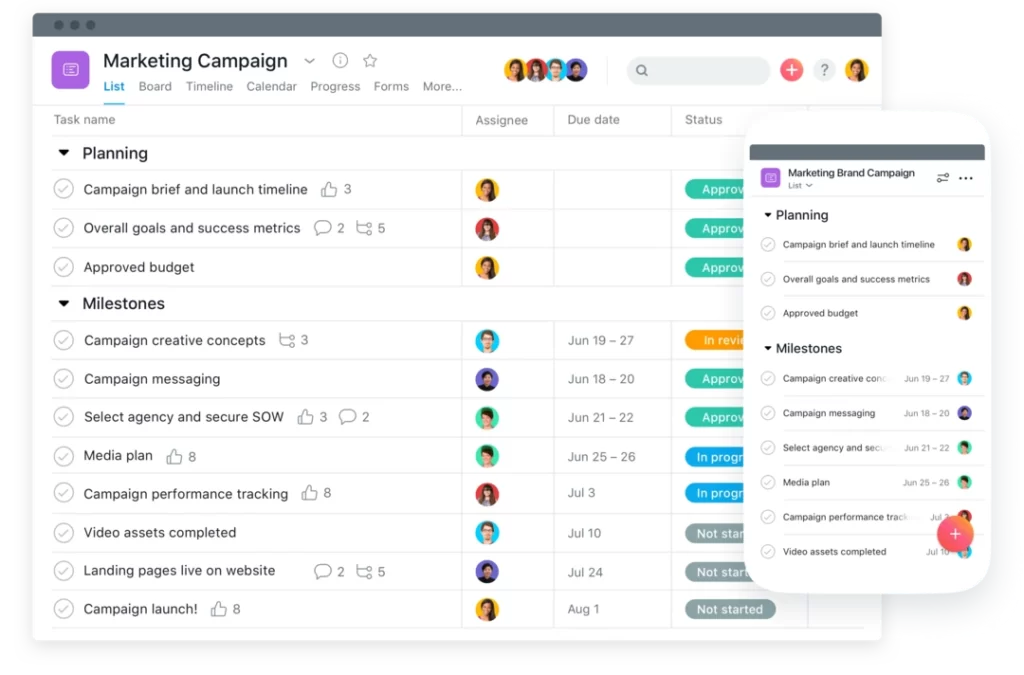
In small businesses, it is expected to lose track of tasks and deadlines as they are never-ending. This is where Asana comes in handy. It is a task management solution that covers all aspects and will help you organise your team again while increasing productivity.
Asana is a robust platform that is easy to use. Many features are available, including creating tasks, assigning them to different people with due dates attached, and then tracking their progress through visual representation on an intuitive interface. You can also customise Board lists and calendars to suit your workflow best.
Collaboration on this app is also outstanding; you can share your work or delegate duties and give feedback right there without having to open another email thread or leave messy comments on Excel sheets somewhere else.
Also, integration with other tools, like Google Drive, Dropbox, and Slack, has been made possible by Asana, thus enabling one to have everything required for work connected and flowing easily during production stages.
Think about being involved in a small web development agency where many clients’ projects are worked on simultaneously. Well, if that’s you, then just know this tool will change how things are done forever!
With Asana, each project gets its dashboard or board filled with cards representing every single step, from wireframing up to deployment, coding/testing, etc, included too… Employees/team members can be assigned specific parts within these boards while setting deadlines and keeping track centrally located.
Also, integrations could come in handy here, especially when it comes down to attaching files/designs/assets required per job directly onto each separate task itself, saving time in terms of retrieval and hence avoiding any unnecessary delays or misplacement
9. Video Conferencing – Zoom

In the current global business setting, it is necessary to communicate with customers, partners and colleagues who may be located in different places. The solution is simple: use Zoom. For small businesses, this video conferencing system is both reliable and user-friendly.
Zoom allows you to host virtual meetings, webinars and video conferences from anywhere with an internet connection. Cloud service technology provides clear audio and visual communication channels.
With a well-designed interface and friendly functions, this software lets you share files easily by dragging them onto your chat area, work together on documents like spreadsheets or presentations while seeing each other’s changes live, and record all or parts of sessions for later reference – among many different things.
More than anything else, though, what sets Zoom apart from its competitors is how seriously it takes security matters: end-to-end encryption ensures that only participants can see what’s being discussed; waiting rooms prevent unauthorised persons from joining calls until approved by hosts; passwords keep unwanted visitors out altogether when appropriately enabled.
In addition to these features, which protect privacy during online meetings, there are integrations available which allow users to improve workflow efficiency even further, such as project management tools like Asana or JIRA connecting directly into your calendar application so deadlines sync automatically across platforms; cloud storage systems, including Google Drive, where meeting recordings can be saved securely, etc.
An Example Of How Zoom Works
Imagine running a small consultancy firm with a clientele dispersed worldwide. Can you schedule and hold virtual conferences, presentations, or training events without hassle through this platform alone? While making proposals or showing reports to clients, one could share their screen and highlight critical areas using the annotation tools, allowing for real-time editing.
Moreover, if team members happen to reside in different countries, time zones, or even continents, bringing them together virtually shouldn’t pose much difficulty since physical distance does not limit anyone’s input during meetings conducted via Zoom
10. Website Builder – Squarespace
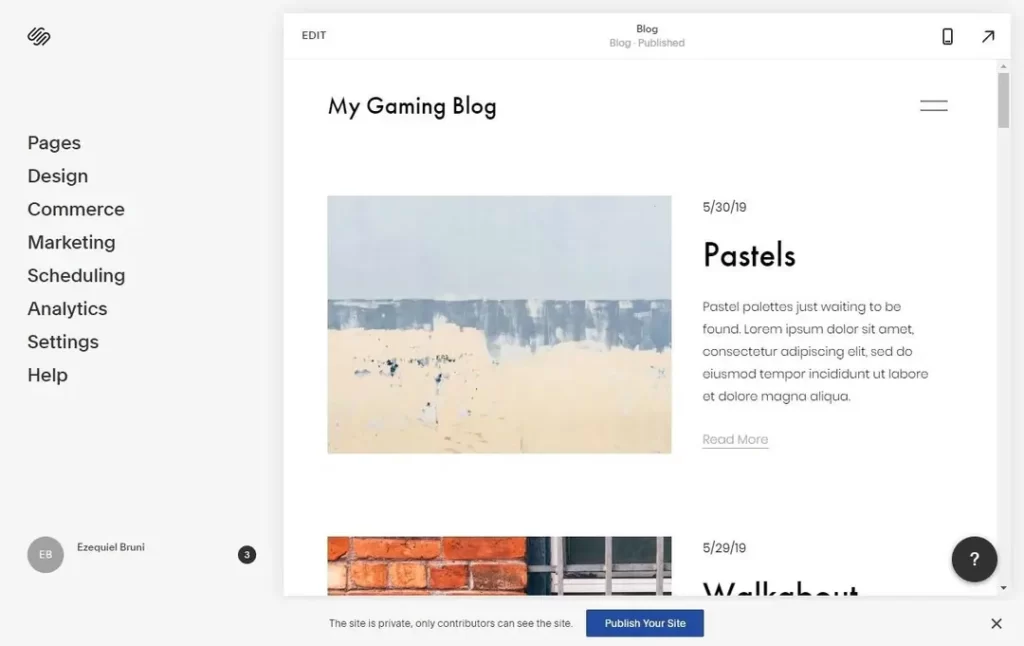
Small enterprises must have a professional and visually attractive online presence in this digital era. However, getting a web designer or agency may be expensive, especially for those just starting.
Squarespace, therefore, becomes very handy by providing a user-friendly website builder that allows owners of small businesses to create beautiful websites even without much coding knowledge.
Squarespace is an all-in-one platform with features like stunning templates and intuitive design tools that help you build sites that represent your brand and captivate your audience. With its drag-and-drop interface and extensive customisation options, creating unique, professional-looking websites explicitly optimised for what you do has never been easier.
One thing that makes Squarespace outstanding, among others, is its e-commerce capabilities. Whether physical products, digital downloads, or services are being sold online, this platform provides everything needed, from setting up shops to managing inventories, processing payments, and tracking orders – all done under one roof!
Moreover, Squarespace also gives robust analytics alongside SEO tools, thus enabling users to track the performance of their sites vis-à-vis search engine rankings while making informed decisions aimed at enhancing their online presence to attract more clients.
Putting Squarespace into Action
Picture yourself as an artist who creates handmade jewellery items on a small scale and wants to create global awareness by selling them online. You can make this dream come true using Squarespace since it allows the creation of visually appealing websites that reflect various brands’ stories, alongside displaying unique designs created by individuals like yourself.
Here, one can establish stores where high-resolution product images, detailed descriptions, and pricing information are uploaded.
Additionally, behind-the-scenes hints may be shared through blogs built within Squarespace so that people get styling tips or inspiration, henceforth connecting better with them and building loyalty among customers, also known as customer relationship management (CRM) software.
Bonus: Workforce Management – Workstatus
Managing a team can often feel like juggling multiple spinning plates—tracking time, monitoring productivity, and ensuring tasks are on schedule. That’s where Workstatus, your workforce management superhero, steps in!
Imagine a single platform where you can track employee hours, monitor team performance, and generate reports effortlessly. Workstatus simplifies workforce management with its easy-to-use interface and powerful features, simplified through payroll attendance software.
From real-time tracking to automated payroll, this tool ensures you save time while keeping your team productive.
But what makes Workstatus truly shine? Its versatility! Whether you’re managing a hybrid team, handling client projects, or streamlining remote work processes, Workstatus adapts to your needs.
Key Features that Set Workstatus Apart:
- Time Tracking: Monitor employee hours with precision.
- Geofencing: Set location-based tracking for on-site teams.
- Employee Monitoring: Gain insights into productivity without micromanaging.
- Automated Payroll: Eliminate manual errors and streamline payouts.
- Integration Options: Connect with tools like Slack, Google Workspace, and Trello for seamless workflows.
Workstatus is an all-in-one workforce management solution that streamlines processes, boosts productivity, and reduces operational costs. Here’s how it drives ROI for businesses:
- Enhanced Productivity: By tracking time and monitoring tasks, Workstatus identifies areas of improvement, ensuring teams focus on high-priority activities.
- Cost Optimisation: Features like automated payroll and geofencing minimise manual errors and improve resource allocation, reducing unnecessary expenses.
- Data-Driven Insights: Generate detailed reports to analyse performance trends and make informed decisions that lead to better outcomes.
- Seamless Collaboration: Integrating popular tools like Trello and Slack improves workflow efficiency, keeping teams aligned and productive.
Workstatus doesn’t just manage your workforce; it empowers businesses to achieve more with less effort, driving better profitability and long-term success.
Conclusion
You just started a trip through the top ten small business tools that will change how you do things. These programs are used in various areas such as project management, social media and website building, among others; they have many features and functions to make your work easier, thus saving time for productivity increase, hence success realisation in small businesses.
Nevertheless, remember that this can only be achieved if they are utilised well by being aware of your unique needs as a businessperson and then choosing an appropriate mix based on those needs. Therefore, feel free to try out new combinations or even integrate these apps to create an effective system that suits all corners of your business.
Therefore, take them and begin moving towards efficiency heights never imagined before. I know that running small enterprises is not easy, but it’s worth trying because once you have the proper skills, the sky is the limit for the success achieved in this sector.
Adopt change, remain interested, and keep gaining knowledge since the digital space keeps changing rapidly, meaning we need more inventions regularly; otherwise, everything will become stale with time. There may come a point where someone like yourself creates another game-changing tool meant for transforming operations within small firms around us.
Remember that success is not final; therefore, one must embrace adaptability accompanied by passion and resilience to remain prosperous throughout their entrepreneurial journey. So buckle up, my friend, because these extraordinary instruments will drive us to greatness within our ventures!
Small Business Tools FAQs
What should I do to choose the right tools for my small business?
Identifying your specific business requirements, objectives, and workflows is essential when selecting appropriate tools. Begin by pointing out pain points or areas that require the most assistance, like project management, invoicing, customer relationship management system (CRM) and marketing. Besides this, you ought to research different software that caters to those needs, but do not hesitate to try them through free trials or demos until you find what suits your enterprise best.
Can this software be integrated?
Yes! Many of these apps allow data sharing between platforms easily through integration features. For instance, one can incorporate their communication platform with a project management tool or email marketing software with CRM (customer relationship management system). This makes workflow smooth & fast while reducing errors due to manual data entry and transfer processes.
What are their prices?
Most vendors provide pricing plans with additional features and capabilities, from free to paid subscriptions. The cost depends on the number of users/clients you have and the needed functionalities, among other factors; thus, it varies widely between various programs. Small businesses also get discounts on some products, so never ignore such offers, but look into them before making a final decision.
How secure are they in terms of handling sensitive business data?
Security measures established by reputable software providers ensure safety at all times; hence, there is no reason to worry about this. These precautions include end-to-end encryption, two-factor authentication, and regular security updates, among many others, though policy statements should always be checked just to be safe!
Is mobile accessibility possible?
Absolutely! Most, if not all, apps have mobile versions which can be downloaded & installed directly into any smartphone or tablet running Android OS (operating system) or iOS (iPhone operating system). This enables users to access their information even when away from office premises, thus enhancing productivity considerably, especially for busy entrepreneurs who are always on the move and need flexibility from anywhere they may find themselves.
What is the best way to train my staff to use them effectively?
Most providers offer customer support resources, tutorial videos, and comprehensive documentation for quick start-up assistance. In addition, some vendors organise special training sessions. In contrast, others give certifications that ensure one’s team has the maximum skills to operate various tools effectively, increasing productivity levels within any organisation. Therefore, do not hesitate to invest much time or money into training because it can bring huge returns later.
Can I modify or integrate this software with my existing systems?
Yes, they can be customised according to the user’s preference and integrated into other applications already used within the company environment. APIs (application programming interfaces) allow developers to create custom extensions that match particular requirements for different units that comprise the whole establishment. At the same time, pre-built integrations with popular third-party systems may also be available, depending on the software involved, plus the ability to customise UIs in some cases, so just check out those aspects before choosing a suitable product for your business needs.

